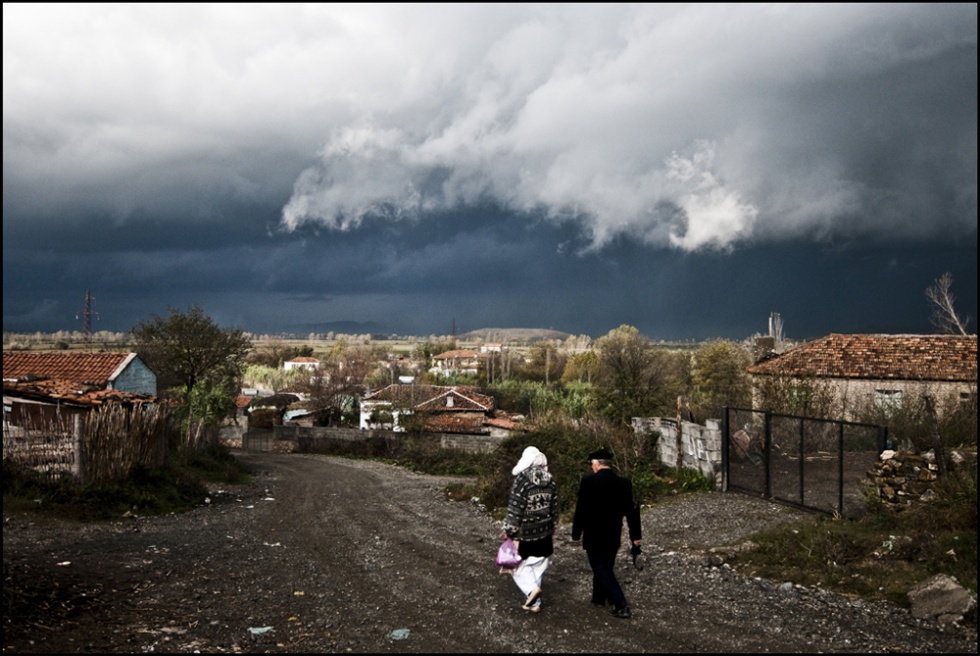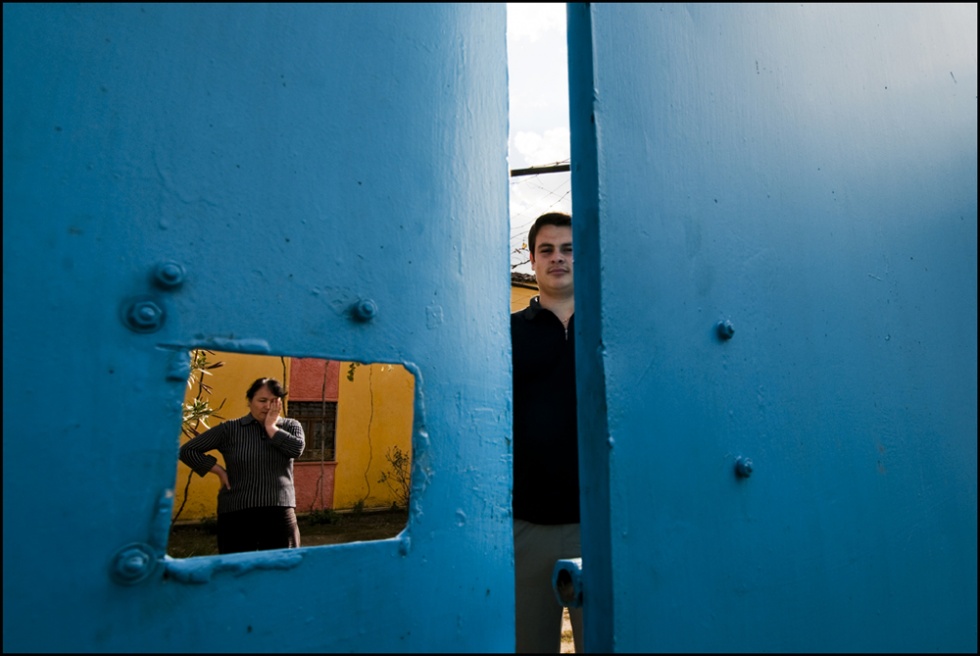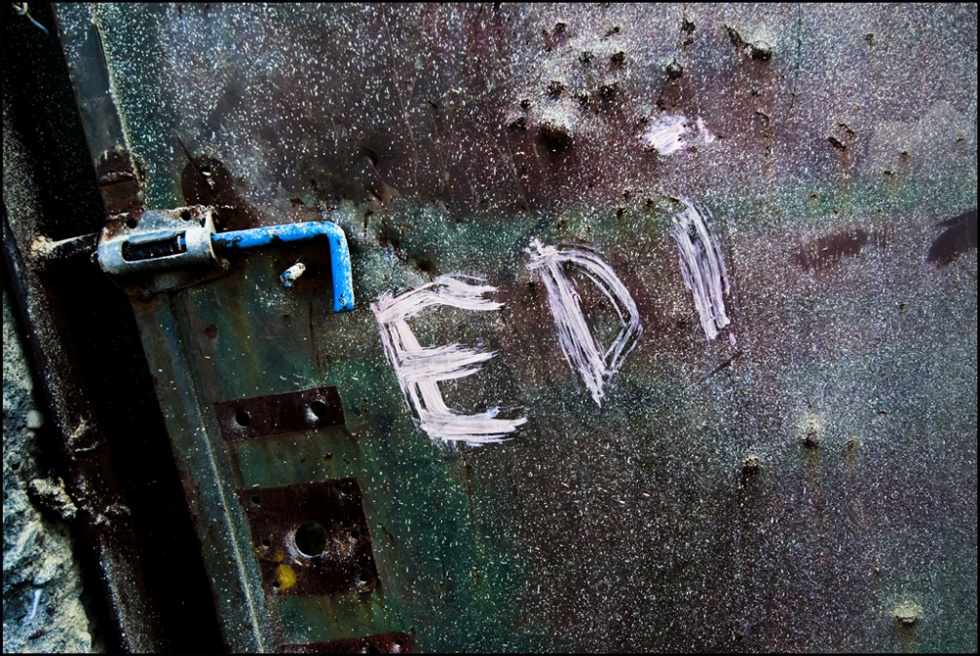In Albania, one of Europe's poorest countries, the centuries-old tradition of blood vengeance has seen a renewal over the past decade. The void in the law-and-order system, left by the collapse of Communism, sent many Albanians back to the common laws of their tribal roots. These laws include also the right, for the membership of a family, to avenge for a murder by killing a member of the murderer’s family.This can be read in the article 8 of the Kanun, that is a set of traditional Albanian laws, the origin of which is traced back to the middle of the 15th century. It was developed by Alexander Dukagjini, hero of the Albanian resistance against the Turks. I got acquainted with this topic when I met Edi, some years ago. Edi is a boy from Kalmet, a town in the North of Albania. He lives shut up in his own home and he isn’t allowed even to go to school.The story of Edi begins four years before, when his father killed two neighbours in a dispute over severed electric cables.His father was killed in turn, but only a part of the vengeance was accomplished. There were two neighbours killed: two victims in return are wanted. Edi’s life is in peril, now. Edi is 16 years old. Since that bloody day he has been living as a prisoner in his own house, together with his mother Rosa, fearing a vengeance. He is safe only among those walls, because the Kanun considers home as an inviolable place. The article 125 of the Kanun says: “All the male members of the murderer's family, including babies, cousins and nephews, even if separated, may be targeted by the revenge”. The phenomenon yet affects women and female children, despite the Kanun prohibit it. At least 160 children have been forced to abandon the lessons during the school hours so far, but this number is probably higher: the Minister of Education said he was determined to tackle the problem, by creating a group of teachers giving lessons directly in the houses where children are locked up. Edi isn't alone. About 2,800 Albanian families are thought to be living in self-imposed isolation, in the attempt to avoid the destiny of victims of blood vengeance. Of course, for none of them there is the chance to work. It took almost two years to me to get in touch with some of the families living these conditions. The most difficult thing was to be welcomed; the second most difficult thing was to get them to talk. In some areas the right of vengeance is even considered an obligation, compelled by the community, with the risk of the complete exclusion. In too many cases this turns into a complete and utter feud, provoking an endless chain of crimes. What I tried to do is to impress into pictures the impact of this situation on the life of a family and especially on its young members. The latter ones, in fact, spend all day stuck in their houses, with nothing to do. I began to gather material in 2009. I met both families fearing vengeance, and families craving for it. I tried to focus on emotional instability, on depression, on anger. The title of my project is “Eye for an eye” and it centres upon the impact of this stalemate on minds and souls. I’d like to convey this situation and support somehow those Mediation Organization that try to bring the only possible solution: forgiveness. I truly think that this project is handling with fundamental matters, especially in a moment in which Albania is one of the candidates for the accession to the European Union. The Foto Visura Grant would allow me to complete this story by showing the most difficult and invisible part: the reconciliation between families. Please consider me as a serious candidate.
stefano schirato
Photographer
EYE FOR AN EYE
Location: Rome
Nationality: italy
Covering:
Africa,
Asia,
Europe,

1 of 35
© 2025 Stefano Schirato
BLINISHT, ALBANIA.
2.800 Albanian families are affected by vendettas in the North of Albania living shut away for fear of reprisals from the opposing family. Blinisht is a small village in northern Albania where several families live stuck in their home because of revenge. In the streets there are always few people.

2 of 35
© 2025 Stefano Schirato
KALMET, ALBANIA.
Rosa, 40 years, and her son Edi, 16 years. He is stuck in his house because of vendetta from 4 years. His father killed two neighbors in a dispute over severed power lines 4 years ago and despite he has been killed by the family of enemies, Edi risks the second revenge because his father has killed two people.

3 of 35
© 2025 Stefano Schirato
KALMET, ALBANIA.
Edi’name written by himself on the entrance gate of his house.

4 of 35
© 2025 Stefano Schirato
KALMET, ALBANIA. Edi's dog.

5 of 35
© 2025 Stefano Schirato
KALMET, ALBANIA. 1000 children do not leave home and no longer attend school. 2000 women have lost their husbands in settling of scores.
The rules governing Albania's blood feuds have been passed down orally as part of the code known as Kanun. The code lays down a strict law to avenge the killing of a family, striking the male relatives of the killer until the third grade

6 of 35
© 2025 Stefano Schirato
KALMET, ALBANIA.
The phenomenon also affects women and children, as men exposed to the risk of revenge despite the Kanun prohibit it.

7 of 35
© 2025 Stefano Schirato
TIRANA, ALBANIA.
Lule, 44 years old. Her brother killed three people in a browle. All male sons are fled to Greece. Lule, even if she is a woman, is afraid that she can raped and kidnapped because of revenge.

8 of 35
© 2025 Stefano Schirato
BATHORE, ALBANIA.
Marku Pietri, 70 years old. His story is full of emotion when he remeber that they arrested his brother wrongly accused of murder. It was 1997. From that date Marku is stuck in his house with fear of revenge.

9 of 35
© 2025 Stefano Schirato
BATHORE, ALBANIA.
Maria, 66 years old, wife of Marku. She shows the knife.

10 of 35
© 2025 Stefano Schirato
RRILA, ALBANIA. A drawing of Diana, a little girl, loked in her house for the fear of vendetta. Her father is in jail because killed his neighbors for ancient problems.

11 of 35
© 2025 Stefano Schirato
RRILA, ALBANIA.
Dila, 31 years old. Her husband is in jail because killed his neighbors for ancient problems. She is coming out of mind. Her male son is escape abroad, and her doughter Daiana, 7 years old, risks the life every time she's living home.

12 of 35
© 2025 Stefano Schirato
RRILA, ALBANIA.
Entrance gate of the house. Dila and her doughter Diana live hidden in the grandmother’s house.

13 of 35
© 2025 Stefano Schirato
LHEJA, ALBANIA.
Alessandro, 7 years old, while playing with a toy. He is unable to attend the school. He’s learning italian from television, dreaming, one day, to visit Rome.

14 of 35
© 2025 Stefano Schirato
LHEJA, ALBANIA.
Agim, 42 years. He injured a fellow at the stomach with a knife and he spent four years in prison. But, despite this, is still under vendetta with the family of the enemy.

15 of 35
© 2025 Stefano Schirato
LHEJA, ALBANIA.
Agim's house interior.

16 of 35
© 2025 Stefano Schirato
KALMET, ALBANIA.
Nusha, 17 years old, is afraid to leave her house since his father killed a woman rightful defense following a dispute over an irrigation canal in close vicinity of the house. From 2 years she doesn’t attend the school.

17 of 35
© 2025 Stefano Schirato
BLINISHT, ALBANIA. Black cat.

18 of 35
© 2025 Stefano Schirato
SHKODER, ALBANIA- KIRAS QUARTER.
Kiras is considered the quarter of vendetta. Is like a ghetto in which people have been hiding in houses because their families 'own blood', which makes them possible victims

19 of 35
© 2025 Stefano Schirato
TIRANA, ALBANIA. Institute quarter.

20 of 35
© 2025 Stefano Schirato
SHKODER, ALBANIA.
Shitani Family: Alexander, 6 years old, Mailinda, 8, Groshe, 55, the grandmother, Vera, 31, the mather and Prof. Leka on the right side.
In December 2007, Besnik, argues with his cousin for trivial reasons. In a fight with other people and definitely drunk, Besnik
hits him with a knife, killing him. Besnik is in a jail, but his family will have to serve the revenge. His sons do not go to school and the teacher Leka, goes to their house to give lessons of school subjects.

21 of 35
© 2025 Stefano Schirato
KALMET, ALBANIA.

22 of 35
© 2025 Stefano Schirato
SHKODER, ALBANIA.
Kristiana Bregu, 10 years old. She moved with her family from Tropoja to Shkoder. Behind them had a history of blood vengeance, finally solved with 2 men dead.

23 of 35
© 2025 Stefano Schirato
SHKODER, ALBANIA.
Kristiana, 11 years old. She moved with her family from Tropoja to Shkoder. Behind them had a history of blood vengeance, finally solved with 2 men dead.

24 of 35
© 2025 Stefano Schirato
SHKODER, ALBANIA.
Fabjian, 17 years old, studing at home. He doesn't attend the school from 3 years. A professor, voluntarily, goes everyday to his home to teach school subjects.

25 of 35
© 2025 Stefano Schirato
SHKODER, ALBANIA.
Gentjana Bregu, 12 years old.

26 of 35
© 2025 Stefano Schirato
RRILA, ALBANIA.
Altin plays with a toy gun. Between his family and the enemy family were killed 7 people. Children grow with a multiple trauma and psychological enormous difficulties in relations and will live with the dream of being able to know the world, to go and play in the nearby lawn next to the house.

27 of 35
© 2025 Stefano Schirato
SHKODER, ALBANIA.
Cristian Luli, 17 years old. Luli family is stuck at home from 1995 because of the fear of Vukaj family’s revenge.

28 of 35
© 2025 Stefano Schirato
SHKODER, ALBANIA.
At least 160 children during the school have been forced to abandon lessons, but the number is probably higher.

29 of 35
© 2025 Stefano Schirato
SHKODER, ALBANIA.
Dede Zef PjetergJoka, 45 years old. He left his brother in a bank robbery. Dede is waiting the good moment to revenge.

30 of 35
© 2025 Stefano Schirato
TIRANA, ALBANIA.Almost every Albanian family has with him some weapons: kalashikov, guns. You can buy it on the street without a license.

31 of 35
© 2025 Stefano Schirato
Halil, 46 years old, was injured in a brawl with a shot of Kalashnikov behind the leg. After three surgical operations, managed not to lose his leg. His family had to do vengeance, but through a broker of peace, they have forgiven the enemy family.

32 of 35
© 2025 Stefano Schirato
SHKODER, ALBANIA.
Sosse Preka, 50 years old. She has 2 sons, Noj, 18, and Florian, 16. Her husband , 5 years ago, killed a neighbour. For 20 years he will remain in jail. His sons are stuck at home for the fear of blood vengeance.

33 of 35
© 2025 Stefano Schirato
Behije Kadri, 73 years old, shows pictures of her two sons, Besim and Ramazan, killed in front of their house 8 years ago. The children of Besim and Ramazan, wanted to escape with the two daughters of a family near their home without marrying them.
The uncle of two girls, named Fasil, killed Ramazan and Besim in the morning in front of their children, with a Kalashnikov.
Now Faslim fled abroad and the family Kadri wants revenge.

34 of 35
© 2025 Stefano Schirato
SHKODER, ALBANIA.
Lina Hili, 42 years old. His husband, Ded Hili, was killed in 1999 by a man in the street, with a gun for a robbery. He worked as an accountant in a small building firm, and he was collect the monthly salaries.
Lina from 1999 is a widow with two children. Guezim, his son, would avenge the killing of his father. But he would be willing to forgive. But often in a small town, neighbors, people murmurs, look how you act, and not to revenge is seen as a lack of courage, as a lack of respect for the rules of Kanun, of a village, as a lack of pride.

35 of 35
© 2025 Stefano Schirato
SHKODER, ALBANIA. Cemetery.
Public Project
EYE FOR AN EYE
2,123
